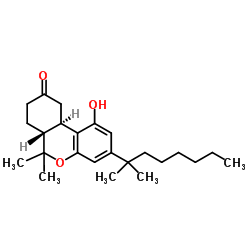Analgesic and antihyperalgesic effects of nabilone on experimental heat pain.
William John Redmond, Philippe Goffaux, Stéphane Potvin, Serge Marchand
文献索引:Curr. Med. Res. Opin. 24(4) , 1017-24, (2008)
全文:HTML全文
摘要
In this study, we explored the analgesic and antihyperalgesic properties of a synthetic cannabinoid (nabilone) on experimental heat pain in men and women, as well as its effects on descending pain inhibitory systems.A double-blind, placebo controlled, crossover study of nabilone single doses of 0.5 and 1 mg was conducted. Excitatory systems were elicited using a temporal summation test (tonic heat pain evoked by a Peltier thermode) administered before and after activation of descending inhibitory control (triggered using a counter-irritation procedure). These tests were given before and after drug treatment. Primary outcome measures included average heat pain, temporal summation of heat pain, and drug-induced changes in the strength of descending analgesia. Possible adverse reactions were monitored throughout treatment. Seven men (mean age = 22.5 years, SD = +/- 1.5) and 10 women (mean age = 23.2 years, SD = +/- 2.8) completed this study.Nabilone (1 mg and 0.5 mg) did not reduce the global pain intensity experienced during tonic heat pain (all values of p > 0.18). It also failed to potentiate the strength of descending inhibitory responses (all values of p > 43). Nevertheless, at the highest dose (1 mg), and only for women, nabilone significantly (p = 0.003) dampened the temporal summation experienced during the last portion of the tonic heat pulse test (i.e., the period of time during which temporal summation is greatest). This antihyperalgesic effect was not observed for men (at either 0.5 mg or 1 mg dose), suggesting that the antihyperalgesic properties of cannabinoids are greater for women than for men. Adverse reactions encountered were generally mild and did not provoke the cessation of testing.Nabilone failed to produce analgesic effects and it did not interact with descending pain inhibitory systems. However, we found that a single 1 mg dose of nabilone reduced temporal summation for women but not men. Although a titration regime and a larger sample of subjects might have provided more robust effects, these preliminary results suggest that nabilone appears effective at relieving hyperalgesic responses in women. Possible neurobiological mechanisms and clinical implications are further discussed.
相关化合物
| 结构式 | 名称/CAS号 | 分子式 | 全部文献 |
|---|---|---|---|
 |
大麻隆
CAS:51022-71-0 |
C24H36O3 |
|
Oral nabilone capsules in the treatment of chemotherapy-indu...
2008-01-01 [Expert Opin. Investig. Drugs 17(1) , 85-95, (2008)] |
|
A randomized, double-blinded, crossover pilot study assessin...
2010-05-01 [Arch. Phys. Med. Rehabil. 91(5) , 703-7, (2010)] |
|
An open-label comparison of nabilone and gabapentin as adjuv...
2011-01-01 [Pain Pract. 11(4) , 353-68, (2011)] |
|
Subjective, cognitive and cardiovascular dose-effect profile...
2013-09-01 [Addict. Biol. 18(5) , 872-81, (2013)] |
|
Cannabinoids in the treatment of chemotherapy-induced nausea...
2012-04-01 [J. Natl. Compr. Canc. Netw. 10(4) , 487-92, (2012)] |